USING VISUAL ARTS IN INCLUSIVE EDUCATION
Using active methods is very important in education. It makes easier to solve problems in imaginative way and creative thinking. Moreover using these methods makes transmitting the knowledge more interesting, helps students find new interests, enables to experience new things often interpersonal. One of the methods is to use varied educational games, that combine elements of fun and learning and most importantly complete substantive knowledge in attractive way. Through those methods you are able to check if students can use this information in practice. There’s one more asset of using educational games: you can regulate difficulty of them, so it’s possible to work with students with different possibilities.
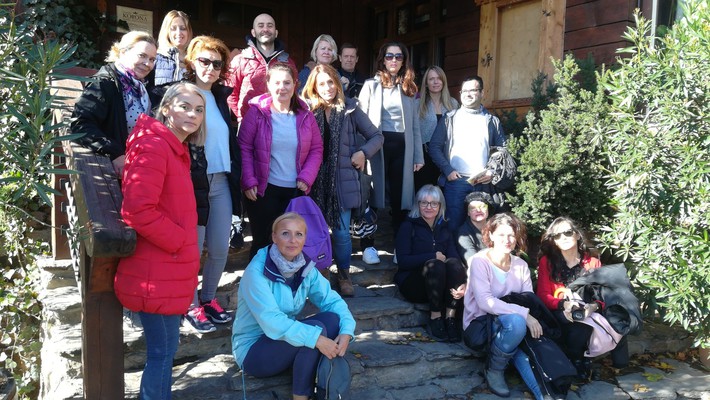
1. Metaphor cards - a useful tool to start a conversation after watching a movie. It allows to express emotions, feelings and reflections about the film and/or characters starring in. It is easier for pupils and students to speak as they do not talk about themselves but about the card. The teacher has the opportunity to learn about the feelings of the audience in indirect way.
The use of metaphor cards is a good tool to work with students and pupils who are usually shy, have problems with expressing themselves, or are unable to speak about their own emotions. Metaphor cards also develop abstract thinking, hierarchization of the content and the skill of telling stories. The most popular metaphors in the world come from the DIXIT game, which can be an interesting form of work during lesson.
During training in Poland we used Dixit cards at the beginning. Each participant had to choose one card which shows his/her attitude to movies and present it to the rest.
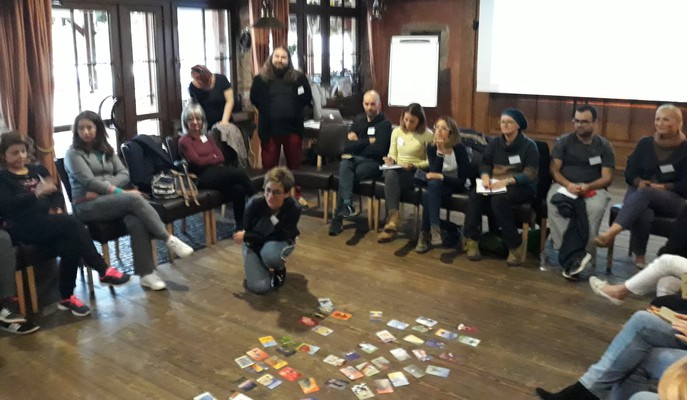
2. Designing film events. When creating movie events at school (such as movie nights, film reviews, school film festivals) it’s good to give the students a leading role in the preparation of materials related to them: they can design posters, tickets and/or presentations. Thanks to this, students have feeling of full participation in the event. The use of design tools will help to include students with different talents (e.g. artistic, graphic, designing) but having difficulties in other fields of education.
A tool called CANVA, available both in the form of an internet website and smartphone applications, can be useful.
During the training in Poland the trainers presented the Canva tool and its possibilities.
3. Storyboard is a method of working with a movie which develops thinking with images. It allows students to draw further sequences of film stories, which can be effective in working with students who have problems with building statements and speaking out. Illustrating the topic can help the students to open for unobvious solutions. It will develop following skills: problem solving, innovative thinking, focusing on the topic or a holistic approach to work with film.
During the training in Poland the participants were divided into groups and had a task to create an ending on the movie presented by the trainers. Each group had worksheets and drew the scenes on it. Then one of participants from each group presented the final version of common work.
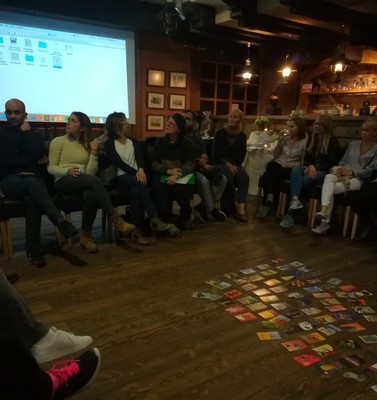
4. Storytelling is not only a method of working with film. It is based on something that humanity has known since prehistoric times. Its use develops the intelligibility of the message - the narration is understandable, because it is based on the concrete (event, character, situation). Using this method involves both – the storyteller and the listener. A well-told story forces the listener to use the imagination, engage the intellect, require concentration and commitment. It is an universal method - it works well in weaker and stronger groups and gives an opportunity for each participant of the groups to discover its abilities. It is based on the power of symbol and allegory, which develops the ability of abstract thinking. Moreover it develops communication skills, because the story must be understandable for the audience. A good story should: have suspense, change the course of action, increases tension, surprises listeners and have specific character/characters. The method develops in the students the ability of storytelling, and at the same time it prepares to talk about their own problems, feelings and emotions.
Useful icons for creating story cards are provided by TheNounProject.comIf you do not have time to prepare cards with icons, you can use a dice game called ‘Story Cubes’, a board game called ‘Comics’ or a multimedia application StoryBird.
During the training in Poland we were divided into groups and the task was to create a screenplay by using received story cards. Additionally, each group created a movie script of a different genre.
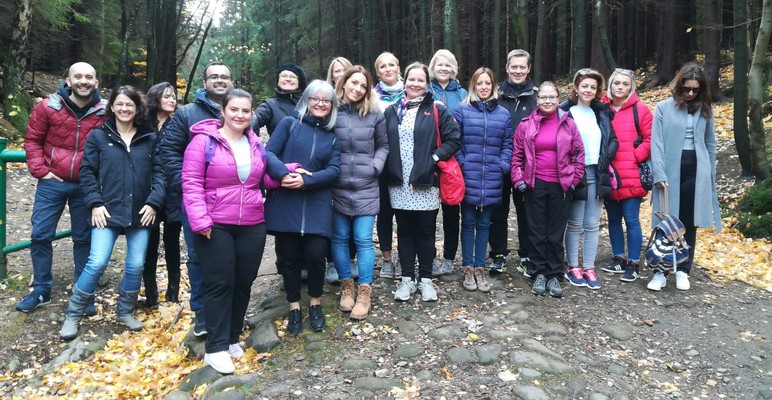
5. Applications: Comica, Picsay, Pixlr, Collage Maker, Stop Motion.
The applications allow the teacher to use new media during lessons and liven up the classes. These applications can be used to build stories, create comic books (e.g. presentation of chosen part of the movie with interpretation), build dialogues and make collages. Both the entire movie or its short part can be the starting point. Additional exercises with building sets, creating costumes and characters strengthen the creativity of children and youth, teach teamwork, provide joy from the very fact of learning. Applications, of course, do not completely replace traditional methods, but help to modernize classes.
During the training in Poland all the participants watched a short fragment of “Romeo and Juliet”. After we were divided into groups and the task was to create costumes, prepare the most important scenes, take pictures of the scenes and prepare a presentation by using one of the applications.
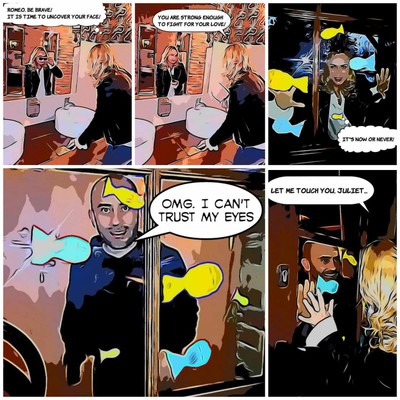
Practical tips
Lesson with storytelling or story writing
Students pick three random cards and create a story based on them. To adapt the level of the exercise to different possibilities/needs of your pupils:
- Basic level: icons from the website TheNounProject.com,
- Average level: Story Cubes or “StoryBird” application,
- Advanced level: Dixit cards (or different metaphor cards).
They must use their imagination and creativity and think of any connotations in order to tell/write something interesting. It can be also done in groups of two students so they learn to respect other person’s opinion. It also shows that no matter how weird someone’s connotations are , everybody’s allowed to express them and not get criticized.
Other method is to give students mysterious, ambiguous cards and ask them to write as many questions to them as possible. Then they have to tell number of questions like: who?, what?, where?, when?, how?; and number of hypothetical and notional questions such as: what if?, what happens next?, what happens when?, where is it going?. They will use the answers to create e.g. comic book, short movie or presentation by using Comica, Picsay, Pixlr, Colage maker, Stop motion applications.
Literature lesson – SET BOOK
We divide class to smaller groups (max four people). Every student gets three Dixit cards that are related to a talked-about set book and chooses one of them. First person puts down on the table chosen card and explains how it’s connected to the book. Rest of the group can see the card. Then the next person must elaborate on the person’s before thoughts, put down another card and explain the connotations between a card and the book.
Lesson about emotions
Divide students into five groups, each of them gets different card. Ask them to identify the situation and emotions this card is stirring or representing. Then students have to prepare creative drama based on this card (or they can film it and present it to the others by using different applications mentioned above). After each group’s presentation the rest of the class must divine the showed emotion.
Lesson about different points of view
Divide students into six groups. First task is to explain the saying: “It all depends on which side of the fence you are standing”. When leaders share their groups’ opinion, give each of them one card. Then, again in groups they’ll have to title it with aphorism, words of wisdom or with a good advice. It will show to the students that every card is ambiguous and may be understand in different ways. Like in real life – the interpretation of the situation can be different for everyone but it doesn’t mean it’s wrong.
Schedule_Meeting in Poland.doc
evaluation of meeting in Poland.pdf